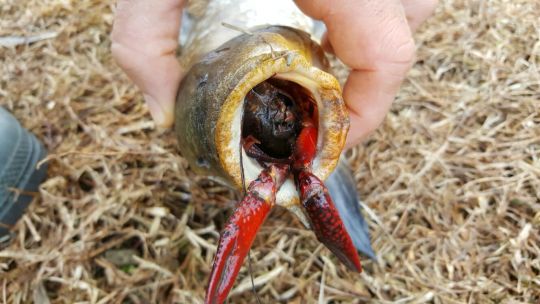(Bonus) Observation of the Week 1/23/17

This Tench with a Red Swamp Crawfish in its mouth, seen in Italy by dinobiancolini and Jacopo Pagani is our (Bonus) Observation of the Week!
(Due to illness and the holidays, it took awhile to get in touch with these gentlemen, so this is belatedly published. Also, English is not Dino and Jacopo’s first language, and I’ve done some light editing of their quotes for this piece.)
Dino Biancolini and his friend Jacopo Pagani, who are both life sciences graduate students at La Sapienza University of Rome, were at Jacopo’s countryside house when Jacopo noticed the large Tench floating in the house’s artificial pond. When they recovered the dead animal, they found that big fish had a crayfish stuck in its mouth!
“Unfortunately, size matters in nature and an error in this sense can be fatal,” says Dino. “[That’s what] likely happened when this fish tried to eat a Red swamp crayfish (Procambarus clarkii) too large for its mouth and died by asphyxiation.”
Dino explains that “this decapod is a very harmful, highly invasive species in Italy that is causing the disappearance of many prey and competitor species. Fortunately some native predators have begun to exploit this new trophic resource, unfortunately with a sad outcome in this case. We thought that the observation was very important for this reasons as well as very odd, so we decided to upload it to iNaturalist.”
Red swamp crayfish are the famed native “crawfish” of Louisiana in the United States, where they are an important culinary item. In fact, they are often raised in rice paddies, a practice that has spread to Asia. These crayfish have been introduced to many areas of the world, including Asia and Europe, where can become quite invasive. They are a vector for Crayfish plague, a mold that has caused serious decline in Atlantic Stream Crayfish, a native European decapod.

Both Dino (above) and Jacopo (below) became fascinated with nature when they were growing up in the country, and that love for nature has led them to pursue to degrees in the natural sciences. Dino currently is a PhD in the Global Mammal Assessment research group, and says “my project aims to predict the future range expansion and invasion of introduced mammals of the world in view of climate and land-use change, to understand their possible impacts on native species.”

And Jacopo says he is “currently a Master’s Degree student in Ecobiology. My thesis is focused on the study of the phenotypic trajectories in Diplodus ssp. associated with ontogeny and diet.”
“I use iNaturalist to help scientific research and enrich my knowledge,” says Dino. “In fact, since I participate in this wonderful project, I learned a lot. Thanks to the community’s help, I can now recognize many more species, both animal and plants, than before, and my vision of biodiversity has been greatly expanded, thanks to the constant flow of observations from around the world that I get.
“I believe that citizen science is a powerful tool for conservation biology because it enhances both data collection and the awareness of general public, two key factors in biodiversity protection.”
- Here’s an informative video from EOL about the Red Swamp Crawfish and its spread around the world.
- And an older New York Times article about Red Swamp Crayfish in Italy.





Comentários
Adicionar um Comentário